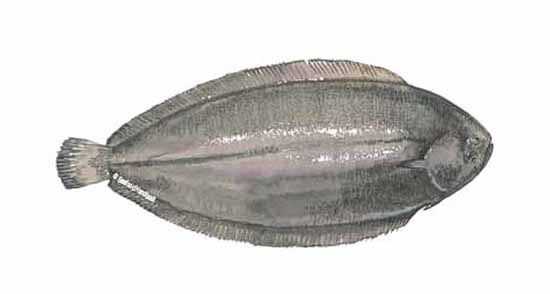Dover Sole

Species Details
Microstomus Pacificus
Pleuronectidae
Pleuronectiformes
Offshore, Deepwater, Nearshore
1 - 10 lbs.
15" - 30"
Dover Sole (Microstomus Pacificus) Fish Description
The Dover Sole or slippery sole is a flatfish mostly found on the northern Pacific Coast. It has a flat-shaped body and a tiny head and mouth with big eyes protruding outward. Their eyes are positioned this way so they can watch for both predator and prey. Its color varies from light olive to dark brown color with blotches of dark brown spots which helps it to camouflage.
It lives in coasts of shallow muddy or sandy shallow waters but can live in deeper parts as well. It usually hunts at night eating other bottom-dwelling animals, such as; worms, small crustaceans, snails, soft-shelled bivalves, and smaller fishes.
Though they’re quite small fish, they can live very long; their max-age is up to 56 years.
Interesting Facts About the Dover Sole
- Dover Sole is considered a delicacy. It is sought after for its firm, creamy, sweet, buttery taste. It is also low in calories, rich in fatty acids, protein, minerals, and vitamins.
- It’s called the slippery sole because it can produce mucous making it hard for fishermen to grab on.
- They use their flat bodies to stay underneath the ground and wait for prey to pass by.
- Juveniles look like your regular fish; they’re not flat and their eyes are on each side of their face, but once it starts to mature, the other eye starts to migrate to the top side and they become flat.
- Despite having sole as a part of its name, the Pacific Dover is actually a flounder.
- The Dover sole shares the same name with another flatfish found in Eurupe. The Pacific Dover (found in USA) should not be confused with the European Dover. They are a completely different species.
Dover Sole's Size & Speed
The Dover sole is a small fish that can weigh up to 10 pounds and can grow up to 30 inches. Its average size is 15.5 inches and 1 to 1 and a half-pound. Females are fairly bigger than males and they mature faster. The males on the other hand can live longer than the females.
You may think that they’re slow a type of fish since they dwell at the bottom, but this flounder is an ambush predator that can quickly catch its unsuspecting prey.
Habitat & Distribution of the Dover Sole
The Dover sole can be found on the majority of the Pacific Coast. Westside – California, Alaska; northern side - the Bering Sea to the western Aleutian Islands; south – Baja California. The majority of catch occurs off the coast of Oregon and California Alaska, West Coast
The Dover sole prefers shallow and muddy waters where it perfectly uses its camouflage. The depth where it stays ranges from 30 – 4500 feet. During winter, they would go to the deeper parts of the water, around 2,600 to 4500 ft, to spawn. The hatchlings prefer colder waters, but once they start to mature, they will slowly rise to more shallow waters.
Each region has different spawning seasons. These are the perfect times for anglers to fly fish a Dover sole - in the Gulf of Alaska, spawning is from January to August; Oregon, November to April; In Puget Sound, it's from January to March.
Fishing Techniques for the Dover Sole
All you need are simple rigs and tactics for fly fishing a small fish like the Dover sole. Using a standard 2 hook flapper rig with a 4-ounce impact lead is enough. You don’t need to go very far for the Dover sole. You’ll be fine at 60-120 feet distance off the shore.
Anglers often focus on getting their lures down to the bottom of the shore when they want to catch a bottom-dwelling fish. To help your lure pinned down to the seafloor, you can use a multiple drilled bullet about 3 inches from the hook. Dover soles have little mouths, so a little size 4 fine wire long shank is enough to catch the fish. The most important on catching the Dover sole is to keep your lure pinned down since these are bottom-dwelling fish. You’ll also increase your chances by using a rod with 2 or 3 hooks in it.
Dover soles are predominantly nocturnal feeders. They’re more active at night to check shallow waters to find food. Nighttime would be your best bet to catch the fish, but they’re pretty plenty so you can catch them at day time as well.
Effective baits for the Dover sole are sliced anchovies or worms. A size 4 hook is enough for their small mouths. Make sure to check your worms every 5 to 10 minutes since they tend to slip away or get drifted by the waves.







